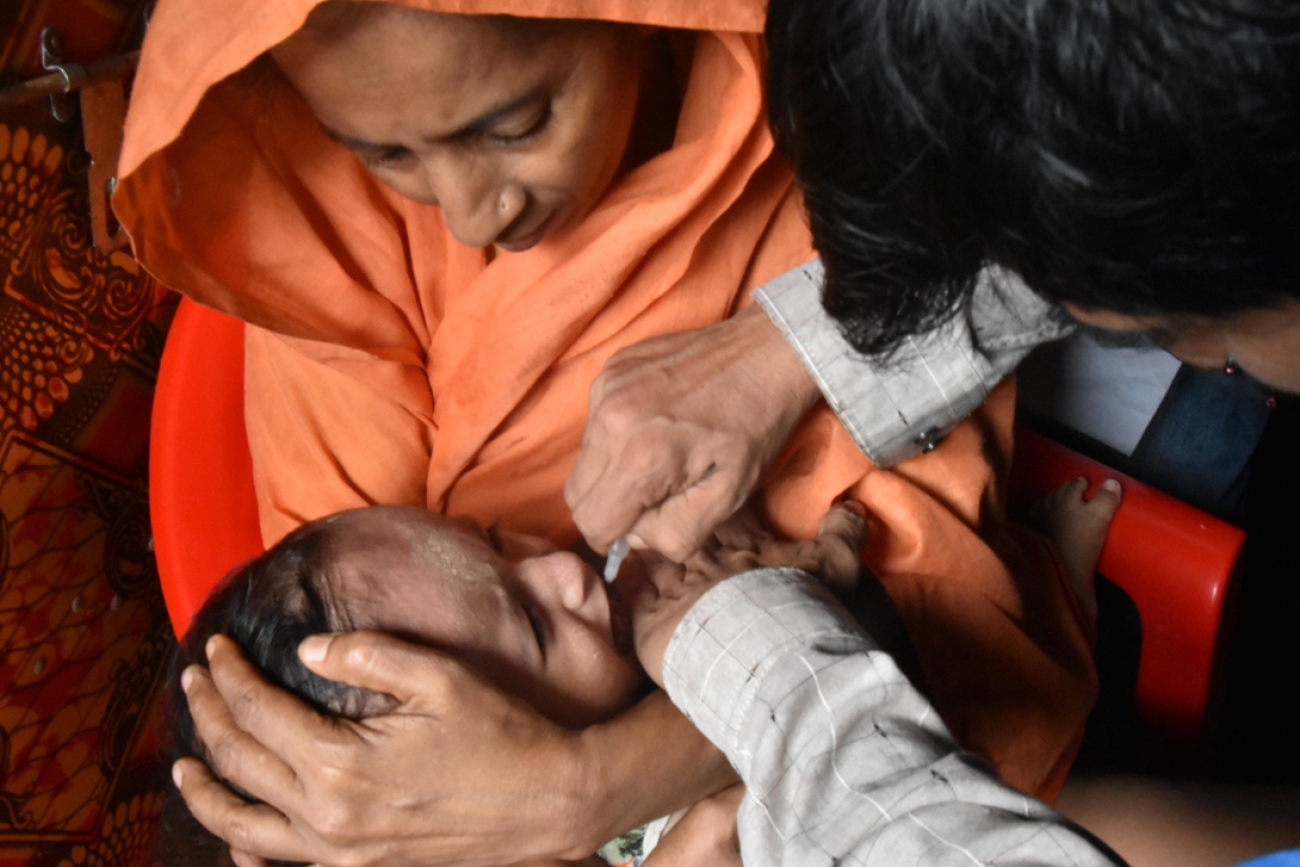Collaborative Polio Vaccination Campaign in Rohingya Camps: A Lifeline for 144,000 Children

12 September 2024
The World Health Organization (WHO), in collaboration with the Government of Bangladesh (GoB), has launched a two-round ‘mop-up’ campaign using the bivalent Oral Polio Vaccine (bOPV) to vaccinate 144,317 children under five years of age in the Rohingya Refugee Camps in Cox’s Bazar. This initiative is part of the WHO Global Polio Surveillance Action Plan 2022-2024.
Poliomyelitis (Polio) is a highly infectious viral disease primarily affecting children under five. The virus spreads mainly through the faecal-oral route or, less frequently, via contaminated water or food. It multiplies in the intestine and can invade the nervous system, causing paralysis.
“As a proud polio-free nation, Bangladesh remains unwavering in its vigilance to uphold this status. This collaborative campaign exemplifies our steadfast dedication to protecting every child's health and ensuring a polio-free future, even in the most vulnerable communities,” says Dr Bardan Jung Rana, WHO Representative to Bangladesh.
Since August 25, 2017, approximately 700,000 Rohingya people have fled to Cox’s Bazar, Bangladesh, due to violence in Rakhine State. As of March 2024, over 942,944 refugees reside in Cox’s Bazar, creating a densely populated environment with heightened health risks, including polio.
In 2014, Bangladesh was certified polio-free by the WHO South Asia regional certification committee, marking a significant public health milestone. However, in January 2024, environmental samples from Rohingya Refugee Camps 21 and 24 detected Sabin-like type 1 poliovirus (SL1) with a seven-nucleotide (7nt) change. This indicated sub-optimal coverage of three doses of bOPV through the routine Expanded Programme on Immunization (EPI), accumulating susceptible individuals.
The presence of SL1 in the environment suggests that the vaccine virus is circulating and potentially undergoing changes that could enable it to cause paralysis, thus becoming a vaccine-derived poliovirus. This poses a significant risk to the health of children in the Rohingya Camps.
To mitigate this risk, WHO and the GoB have launched a two-round ‘mop-up’ campaign using bOPV. This campaign, part of the WHO Global Polio Surveillance Action Plan 2022-2024, aims to vaccinate 144,317 children under five years of age in the Rohingya camps at Ukhiya and Teknaf, Cox’s Bazar, with two doses of bOPV.
“This campaign exemplifies our steadfast dedication to eradicating polio and safeguarding every child's health, paving the way for a polio-free future in even the most vulnerable communities,” says Dr Jorge Martinez, Head of the WHO Sub office in Cox’s Bazar.
The two-round campaign was conducted from July 14-31, 2024, and September 1-12, 2024. 1,650 Community Health Workers (CHWs) and 140 Community Health Supervisors (CHWS) conducted house-to-house visits across the 33 camps in Ukhiya and Teknaf to ensure high immunisation coverage.
The primary goal of this WHO-funded campaign, which includes vaccine procurement, implementation costs, and technical support, was to achieve high immunisation coverage. This will protect the population from polio and reduce disease-related mortality and morbidity. The campaign aimed to prevent the circulation of vaccine-derived poliovirus by ensuring adequate coverage.
By the conclusion of the first round, 176,052 children (122% of the target) received the bOPV vaccine, exceeding our goal of 144,317. In the second round, the target was 176,052, and 175,482 children (99.7% of the target) received their second dose. Also, 7,497 children received their first dose during the second round, including 1,957 newly arrived children (Fig. 2).
This vaccination campaign was a critical step in safeguarding the health of Rohingya children and underscores the global commitment to immunisation and continuous efforts to reach every child, especially in vulnerable communities.


